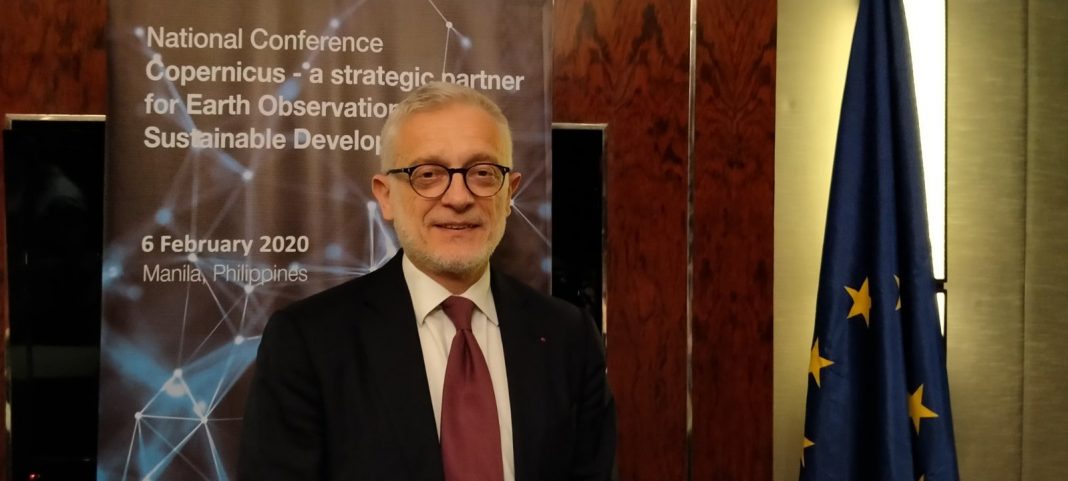Text and photos by Monsi A. Serrano
In this fast-changing world and unforeseen circumstances, having a reliable partner who would fill what you lack can make your life easier.
Such is the case between the partnership of the Europoan Union and the Philippines with the use of technology with several useful and relevant applications, Copernicus.
Yesterday, at the 2nd National Conference on Space Programme Copernicus was held in Makati City, EU’s Copernicus’ capabilities such as providing accurate, timely, and easily accessible information to improve the management of the environment, understand and mitigate the effects of climate change, and ensure civil security were revealed.
The Copernicus is the EU’s Earth observation tool that draws on data and in situ (onsite or local) measurement systems. The programme is supported by a family of dedicated, EU-owned satellites – the Sentinels – designed to meet the needs of the Copernicus services and their users.
Among the many unique features of this programme is its ability to monitor the Earth to ensure that citizens are prepared and protected during natural or man-made disasters. Apart from providing high-resolution global spatial coverage, the Copernicus programme promotes free and open use of its information to all its users.

(Photo from EU in the Philippines)
During the Second National Conference on the EU’s space programme, Science and Technology Secretary Fortunato de la Peña welcomed the Copernicus as a system which has given the Philippines “different opportunities to develop Earth observation applications for disaster risk reduction and management, environmental protection and climate change adaptation”.
Our country’s Science and Technology Chief said that the Philippines has been a heavy user of Sentinel data and that through the Sentinel Australasia Regional Access, data and user products from Copernicus satellites Sentinel – 1, Sentinel – 2 and Sentinel – 3 are now easily accessible to scientists and engineers at the Philippines’ Department of Science and Technology.
Gathered data through the orbiting satellites can be analysed and processed in real-time to become weather forecasting, climatic environmental and geological monitoring information. This helps in determining rainfalls and temperature, identifying land degradation, resource extraction, spread of insect borne-diseases, crop yields or managing disasters.
This prospective new cooperation aims to address the key objectives of the Philippine government to develop and utilise Earth Observation satellite applications to enhance hazard management and disaster mitigation strategies and to further strengthen the country’s resilience to climate change.
Meanwhile, Dr Philippe Brunet, Principal Advisor to the European Commission Directorate for Cooperation and Development, affirmed this prospective bilateral cooperation on space programme.
He said that the European Union is looking at the possibility of implementing a national capacity support programme on Copernicus towards the end of the current year as the first step in close cooperation with the Department of Science and Technology. Dr Brunet was former EU Director for Space Policy, Copernicus Programme and Defence.
The initial discussions between the EU and the Philippines focused on disaster risk reduction and climate change adaptation, forest monitoring, and marine pollution and marine litter.
Speaking to THEPHILBIZNEWS, Dr.Brunet said, “This will be very helpful in a disaster-prone country like the Philippines. So many usage that would really make you appreciate the technology.”
Going beyond the Philippines

(Photo By Monsi A. Serrano)
Dr. Brunet explained when he asked if the partnership of the Copernicus programme is just limited to the Philippines, and he said they are also open to working with other regions and parts of the world.
“We are happy about our partnership with the Philippines, but we also look forward that eventually, we would be able to work with other countries. The European Union is exploring the possibility to create a network of Copernicus partners in the ASEAN region aside from other parts of the world,” Dr Brunet added,
He also said that the EU is hopeful that through the programme, it will be able to mainstream use of information in development assistance operations.
Since becoming operational six years ago, Copernicus has become an excellent example of European cooperation and is the world’s leading provider of earth observation data and information, he said.
Copernicus supports evidence-based policy, create economic opportunities, encourage innovation and contribute to better disaster risk management and emergency response and tackle challenges of global nature.
The journey for both the EU and the PH as partners is gearing up amidst some challenges, but, definitely, through the Copernicus Programme, its bilateral relations will all the more be strengthened.














